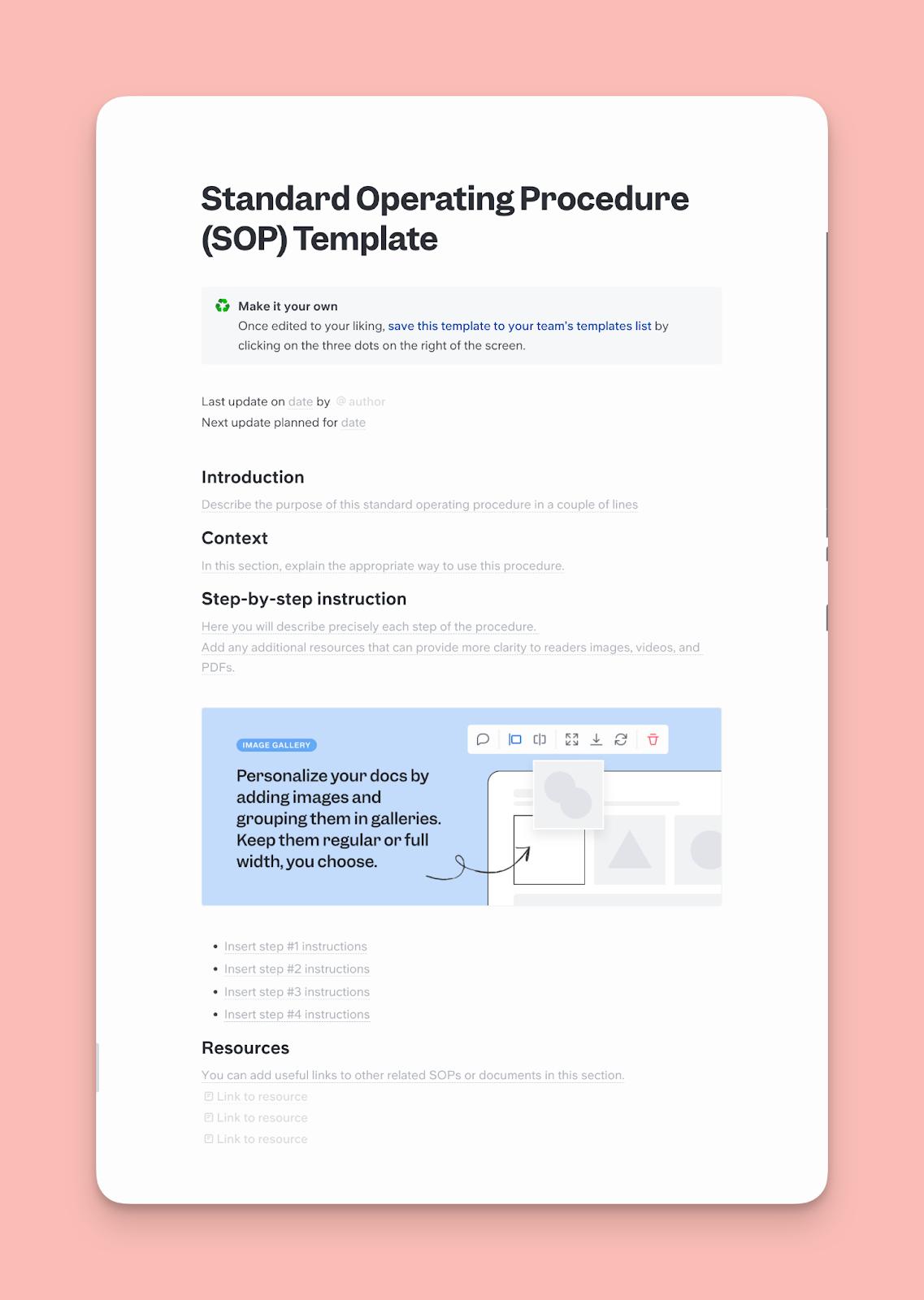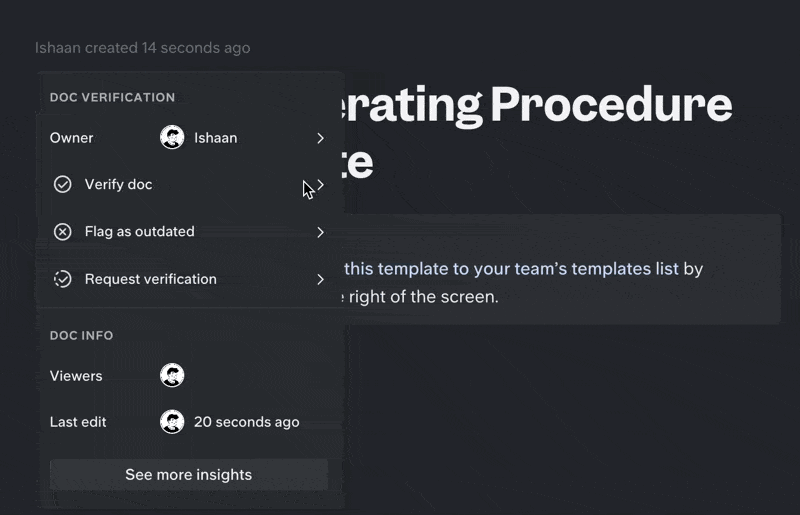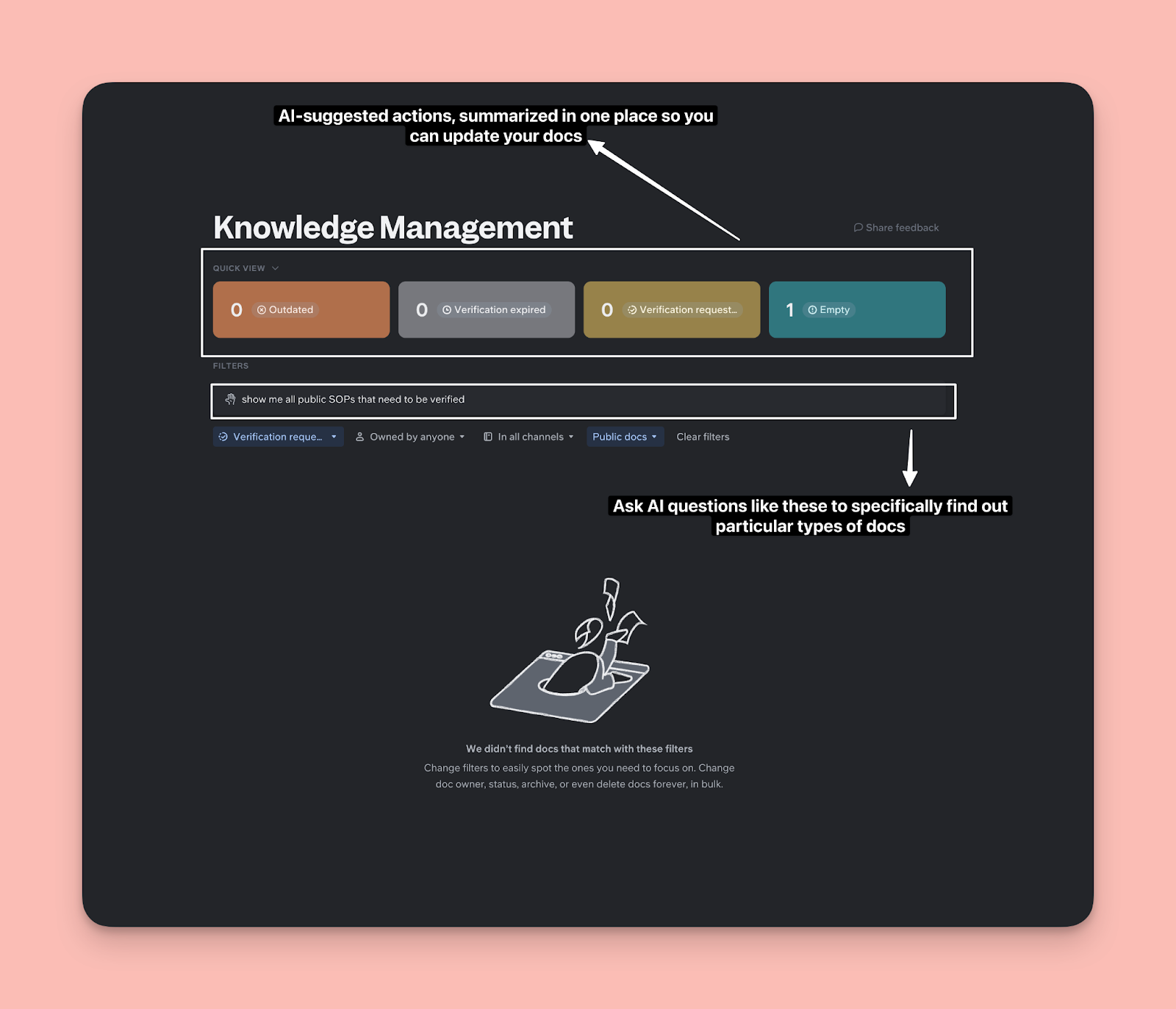How to write SOPs? Templates included
What exactly are SOPs?
SOPs are detailed, step-by-step instructions that define how essential tasks within your business should be completed. They cover the who, what, when, where, why, and how of getting things done, acting as a blueprint for consistent execution.
SOPs might seem like dry documents, but for sales teams, they're a game-changer. Mark Damsgaard, Founder of Global Residence Index, experienced this firsthand: "Sales SOPs allow companies to have a consistent quality of service." This consistency means that your customers and prospects know what to expect, creating trust and reliability – key elements of a successful sales process.
SOPs can change companies overnight
Vaishaly Sethi currently leads all things Sales at AulaCube. But when she was just starting out, for two frustrating years, she believed her product was superior, but connections seemed to drive more success than the actual quality. Vaishaly's SOP amounted to counting meetings, leaving her eager to learn a better way.
Then came an unconventional new sales leader. This leader shunned the focus on building endless relationships, instead prioritising direct outreach to decision-makers. The strategy: uncover real needs, then show how the product solved them. No time wasted – deals closed (or died) within a few visits, not dozens. This shifted the team's mindset, doubling their average revenue. Vaishaly personally became a top performer, generating significant individual wins.
From this transformation, a new SOP emerged. Instead of just focusing on outcomes, they meticulously tracked activities that moved deals forward: meetings with decision-makers, demos, negotiations. This streamlined process (FO, NE, PR, FN, DL) became Vaishaly's guiding star for the next decade. She built high-performing teams across companies, always battling the mindset that prioritised socialising over a quality product and proven process.
Currently, Vaishaly is pushing great SOPs to replicate their strategy at the operational level. They're replacing armies of in-person salespeople with virtual demos, figuring out ways to get to the decision-makers faster, and just closing more deals.
SOPs aren't just about saving a few minutes here and there. When done right, they become catalysts for rapid change. Her initial years were mired in the old, inefficient ways. Yet, the shift to a process-driven approach wasn't a gradual evolution – it led to immediate, dramatic results.
Different Types of SOPs
There’s 3 different types of SOPs:
General SOPs
Purpose: Provide general instructions for performing a task that is done in a similar manner across multiple departments.
Characteristics:
- Broad in scope, covering a wide range of activities.
- Provide a general framework for completing a task, but may not include specific details or variations.
- Often used for tasks that are routine and have a well-defined process.
Examples:
- SOP for handling customer inquiries
- SOP for processing purchase orders
- SOP for maintaining equipment
Instructional SOPs
Purpose: Provide detailed, step-by-step instructions for completing a complex task that requires multiple actions.
Characteristics:
- Narrow in scope, focusing on a specific task or process.
- Provide detailed instructions, including specific steps, and potential challenges.
- Often used for tasks that are complex, require specialized knowledge, or have a high risk of error.
Examples:
- SOP for conducting a safety audit
- SOP for installing software
- SOP for responding to a data breach
Administrative SOPs
Purpose: Provide instructions on how to complete administrative tasks related to HR, accounting, or other administrative functions.
Characteristics:
- Focused on administrative tasks, such as hiring, payroll, or invoicing.
- Provide clear instructions on how to complete administrative processes, including required documentation and approvals.
- Often used to ensure compliance with laws, regulations, or internal policies.
Examples:
- SOP for hiring new employees
- SOP for processing expense reports
- SOP for managing vendor contracts
Different Formats of SOPs
Simple Format
The simple format is a straightforward and easy-to-understand format that is well-suited for basic tasks. It typically consists of a list of step-by-step instructions, with each step clearly defined and in chronological order. The simple format is often used for tasks that are routine and have a limited number of steps.
Hierarchical Format
The hierarchical format is a more complex format that is well-suited for tasks that have multiple branches or decision points. It typically consists of a tree-like structure, where each branch represents a different possible outcome or decision. The hierarchical format allows for easy identification of the different steps involved in a task, as well as the potential outcomes of each step.
Flowchart Format
The flowchart format is a visual format that depicts the steps and decision points of a task using a series of symbols and arrows. It is often used for tasks that are complex and have multiple possible outcomes. The flowchart format allows for easy visualization of the task flow and can help to identify potential bottlenecks or inefficiencies.
Key Elements of Effective SOPs
So, what makes a truly great SOP? Here's a breakdown of the must-have elements:
- Clear Title: In a few words, tell people exactly what the SOP covers.
- Purpose: Briefly explain why this SOP is important.
- Who's Involved: Specify which team or roles this SOP is for.
- What You Need: List any tools, software, or materials required.
- Step-by-Step: Break the process into simple, numbered steps.
- Pictures Help: Use visuals like screenshots or diagrams if they make things clearer.
- Quality Check: Define what success looks like (metrics, standards).
- Safety First: Highlight any potential risks and how to avoid them.
- Troubleshooting Tips: Anticipate common problems and offer solutions.
- Version Control: Track updates with a version number and dates.
Your team benefits from great SOPs, a lot.
For managers, SOPs reduce the burden of constantly monitoring and training employees on the same tasks. Instead of answering repetitive questions, managers can point staff to documented procedures. This frees up time for more strategic responsibilities.
For employees, they offer self-sufficiency to complete duties without reliance on others. Confidently following high-quality SOPs helps staff work more autonomously. Well-documented processes also aid new employee onboarding and cross-training.
For the wider business, SOPs mean less wasted time, faster output, lower risks, reduced costs, and increased scalability. Smooth, standardised operations create competitive advantage by allowing teams to deliver consistent quality at scale.
How to document SOPs that work for every team member? - A step-by-step guide
Follow this five-step plan to create living SOP documents your team will actually use:
Step 1: Dive into the “Real Work”
Focus on the most important tasks. It's easy to get overwhelmed trying to document everything. Prioritise the tasks that happen frequently, have a big impact on outcomes, and tend to cause problems if not done correctly.
Don't fall into the trap of assuming you know how everything works. Schedule time to observe your team members in action, whether that's sitting by their side in the office or hopping on a screen share for remote employees. Take detailed notes about business processes, ask open-ended questions, and be on the lookout for those hidden opportunities to improve.
The people doing the work every day have the deepest understanding of the process. Ask them questions like: "Walk me through your process – what are the exact steps involved?", "Is there a particular order you need to do things in?", "What are the common bottlenecks or places where mistakes happen?" or "Can you think of any ways to make this faster or simpler?"
Step 2: Make it easy to follow
Take that complex process and break it into smaller, easily digestible steps. Begin with a general overview of the task, and then get into the finer details – think of it like zooming in on a map.
Use a mix of paragraphs for explaining concepts or providing context, and numbered lists for steps that must be done in a specific sequence. Consider using flowcharts for complex processes with multiple decision points.
Screenshots, diagrams, or even short videos can make complex tasks much easier to understand. Remember, the key is clarity – use plain language and active voice to avoid confusion.
And if you’re getting confused with the doc structure, try starting off with Slite’s free SOP template:

Want to check it out? Start with Slite’s SOP format for free here.
Step 3: Optimise every step
As you're documenting the process, be ruthless about efficiency. Question every step, and try to find a faster, simpler, or more reliable way to do it. Identify and eliminate any redundant or unnecessary steps. Explore whether technology could take over part (or all) of the process. Consider simple automation tools, especially for remote teams, to streamline repetitive tasks.
Pay special attention to places where tasks get passed between people. Make those handoffs seamless, even if your team is spread across time zones. Recommend tools or communication structures that prevent work from stalling. Finally, build in smart spots to prevent errors, saving headaches later. Here’s a couple of the best automation tools (for marketing, CRMs, daily workflows, etc.) used by B2B SaaS startups that you can check out:
- Zapier
- IFTTT
- Buffer
- Hootsuite
- Later
- Hubspot
- Salesforce
Step 4: Pick a cloud based knowledge base app
Choosing a cloud-based solution (like Slite!) is key. And here’s why.
Unlike most documentation tools, Slite is being built to give teams the most advanced and easy-to-use knowledge base. Over 200,000 teams have signed up with Slite and storing internal processes is a primary use case for most of them.
But why should you prefer a paid platform like Slite for your SOPs?
- You want a beautiful, no-BS UI. Slite users report that it has the least learning curve compared to tools like Notion, Confluence, etc. So, everyone in your team can use it like a breeze.
- You want built-in AI features for writing faster. Slite’s editor lets you improve docs, summarise them, proofread them, etc. - in just a couple of clicks, in real time. Meaning your writing time gets reduced drastically.
- You want to make your SOPs easy to find. Slite plays well with Slack, your chrome browser, and all your project management apps. You can retrieve SOPs using Slite’s Chrome extension or directly tag Slite in your Slack workspace.
- You don’t want the fuss of teammates asking, “Is this up-to-date?” - Slite’s document verification features let you put a stamp of approval to every doc you write.

5. You want to be automatically notified when an SOP should be updated. Moreover, all of your suggested actions can be viewed in one glance using Slite’s Knowledge Management Panel.

Step 5: Keep improving it
Set a regular reminder (maybe quarterly) to review your SOPs and make sure they're still accurate. This is especially important for remote companies, where processes might change more frequently without in-person observation.
Update SOPs promptly as workflows evolve, and make those updates visible to everyone. Encourage team feedback on how to improve your SOPs. Remote teams may need extra communication channels dedicated to SOP discussions.
Remember: SOPs are about empowering your team to succeed, saving headaches, and making work smoother for everyone – whether you're down the hall or across the world.
Once documented, 5 tips to improve them with time
Get your team to buy in
Think of your SOPs as a collaborative project, not a top-down rulebook. Your team members who do the work daily are the experts on how things actually get done. Therefore, they’re equal stakeholders in your SOPs. So involve them from the start. Not only will this make your SOPs more accurate, but it also helps boost morale and ownership over the processes themselves.
A picture's worth a thousand words (especially for complex workflows)
Sometimes, text just doesn't cut it. Include screenshots, step-by-step diagrams, or even short how-to videos to make those tricky docs more interactive. Flowcharts are awesome for mapping out processes with multiple steps or decision points – it's like a visual roadmap for getting work done. Our best tip for this is to use a scrappy in-line sketch that gets the point across.
For example, while working on a new SOP, try creating a simple in-line flowchart at the end of the steps to aid visualisation. If you’re using Slite, just go to the next line and type /sketch, you’ll immediately be able to create a flowchart in-line. It works for annotating images too!
We personally love using async video tools for this because of how fast and easy they are, especially for SOPs. Read more about how we use async video across our documentation here.
Keep the jargon out
Not everyone speaks your department's lingo. Define any specialised terms or acronyms in a simple glossary alongside your SOPs. This is especially important when SOPs are shared between teams or when onboarding new hires who aren't familiar with your company-specific terminology just yet.
Set standards
Quality matters. Before you sign off on an SOP, define what "success" looks like, using measurable standards if possible. This helps prevent misinterpretations and ensures consistently good results. Remember, though, a little flexibility empowers your team – think of these standards as guidelines, not unbreakable laws.
Test Drive Your SOPs
Don't release an SOP into the wild without a test run. Ask someone less familiar with the process to follow your instructions and see if they get the expected results. This is your chance to catch any confusing bits or missing steps before the SOP becomes official.
Final Words: SOPs Are an Investment, Not a Chore
Yes, creating effective SOPs takes some upfront effort. But think of it as investing in the long-term success of your team. Well-written SOPs reduce confusion, boost efficiency, and create a smoother experience for both employees and customers. They free up your time to focus on strategy rather than firefighting. And most importantly, they empower your team to reach their full potential.
That's not just a nice idea: it's a workflow transformation with measurable results. When done right, SOPs become the bedrock of a high-performing, scalable, and resilient organisation.
Ready to Get Started? Slite's Got Your Back
Crafting great SOPs doesn't have to be complicated. Let Slite be your guide and toolkit:
- Templates to Kickstart Your SOPs: Don't want to stare at a blank page? Our template gallery has structures for common processes, ready for you to customise and play on SOP examples.
- Magic Document Formatter to turn a bad SOP into a great one: Got an existing SOP that's more chaotic than helpful? Our Magic Doc formatter instantly adds clear formatting and structure with just a few clicks.
- Need Expert Guidance? If you're building a whole SOP system or tackling complex workflows, our team is here to help. Book a demo and see how Slite can streamline your processes even further.
